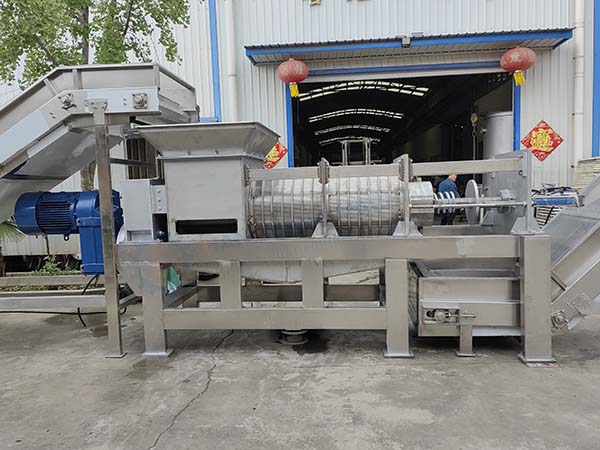Organic waste dewatering machine
Contents |
[edit] Introduction
In the realm of waste management innovation, the fruit and vegetable waste dewatering machine emerges as a transformative solution, effectively reducing waste volume and environmental impact. This cutting-edge equipment employs a straightforward yet highly efficient mechanical squeezing mechanism, swiftly eliminating moisture from fruit and vegetable waste, positioning it as a pivotal tool for modern waste processing.
[edit] Working Principle
At its core, the screw dewatering machine relies on the mechanical compression of waste material to expedite the removal of moisture. This process not only significantly decreases the weight of the waste but also reduces its volume, marking a substantial leap forward in waste management efficiency.
[edit] Processing Workflow
The operational workflow of the machine encompasses several key steps, including feeding, dehydration, and residue discharge. As fruit and vegetable waste is introduced into the machine, an internal screw squeezing mechanism efficiently removes moisture. The residue discharge outlet then expels the remaining solid waste, completing a comprehensive and streamlined processing cycle.
[edit] Advantages
1. High Efficiency and Energy Conservation
The adoption of mechanical compression accelerates the dehydration process, achieving remarkable efficiency within a short time frame. Simultaneously, the liquid solid separation equipment minimises energy consumption, aligning with modern energy-efficient practices and contributing to a more sustainable operational model.
2. Volume Reduction
By effectively dehydrating fruit and vegetable waste, the machine significantly reduces the volume of waste, making it more manageable for subsequent processing and transportation. This reduction in volume not only improves logistical aspects but also contributes to a lighter environmental footprint.
3. Environmental Protection
Dehydrated fruit and vegetable waste are more easily managed and prone to decomposition, reducing the risk of soil and water pollution. This aspect of the machine's functionality is crucial for creating a cleaner and healthier ecological environment, aligning with global environmental preservation goals.
4. Recyclability
The reduced moisture content in dehydrated waste enhances organic material concentration, providing an optimal foundation for the production of organic fertilrers. This process fosters a closed-loop system, emphasising the recycling and reuse of resources, thereby contributing to a more circular and sustainable economy.
[edit] Operating Guidelines
1. Adherence to Standard Operating Procedures:
Operators must be well-versed in the correct usage of the equipment to ensure its smooth operation and the effective processing of fruit and vegetable waste. Strict adherence to standard operating procedures is fundamental to maximising the machine's potential.
2. Regular Maintenance:
Routine inspections and maintenance routines are essential to uphold the proper functioning of the dewatering machine. This proactive approach not only ensures the longevity of the equipment but also contributes to sustained operational efficiency.
3. Safety Precautions:
In the course of operation, strict adherence to safety measures is imperative. This ensures the well-being of operators, preventing injuries, and guarantees the secure and reliable operation of the equipment.
[edit] Conclusion
In conclusion, the fruit and vegetable waste dewatering machine represents a significant leap forward in waste management technology, offering an efficient, environmentally friendly, and sustainable solution for processing fruit and vegetable waste. Its innovative design, multifaceted advantages, and commitment to operational excellence make it an invaluable asset in the global effort towards responsible waste management and resource conservation.
- = Related articles on Designing Buildings =
- Anaerobic digestion.
- Biomass.
- Biogas.
- Circular economy.
- Composting.
- Disposal.
- Environmental impact assessment EIA.
- Reduce, reuse, recycle.
- Recycling explained
- Site Waste Management Plans – A Necessary Burden.
- Types of fuel.
- Waste and Resources Action Programme WRAP.
- Waste hierarchy.
- Waste management plan for England.
- Wishcycling.
- Working with lighting maintenance contractors.
- Anaerobic digestion.
- Biomass.
- Biogas.
- Natural resource.
Featured articles and news
The UK's Modern Industrial Strategy: A 10 year plan
Previous consultation criticism, current key elements and general support with some persisting reservations.
Building Safety Regulator reforms
New roles, new staff and a new fast track service pave the way for a single construction regulator.
Architectural Technologist CPDs and Communications
CIAT CPD… and how you can do it!
Cooling centres and cool spaces
Managing extreme heat in cities by directing the public to places for heat stress relief and water sources.
Winter gardens: A brief history and warm variations
Extending the season with glass in different forms and terms.
Restoring Great Yarmouth's Winter Gardens
Transforming one of the least sustainable constructions imaginable.
Construction Skills Mission Board launch sector drive
Newly formed government and industry collaboration set strategy for recruiting an additional 100,000 construction workers a year.
New Architects Code comes into effect in September 2025
ARB Architects Code of Conduct and Practice available with ongoing consultation regarding guidance.
Welsh Skills Body (Medr) launches ambitious plan
The new skills body brings together funding and regulation of tertiary education and research for the devolved nation.
Paul Gandy FCIOB announced as next CIOB President
Former Tilbury Douglas CEO takes helm.
UK Infrastructure: A 10 Year Strategy. In brief with reactions
With the National Infrastructure and Service Transformation Authority (NISTA).
Ebenezer Howard: inventor of the garden city. Book review.
The Grenfell Tower fire, eight years on
A time to pause and reflect as Dubai tower block fire reported just before anniversary.
Airtightness Topic Guide BSRIA TG 27/2025
Explaining the basics of airtightness, what it is, why it's important, when it's required and how it's carried out.
Construction contract awards hit lowest point of 2025
Plummeting for second consecutive month, intensifying concerns for housing and infrastructure goals.
Understanding Mental Health in the Built Environment 2025
Examining the state of mental health in construction, shedding light on levels of stress, anxiety and depression.






















